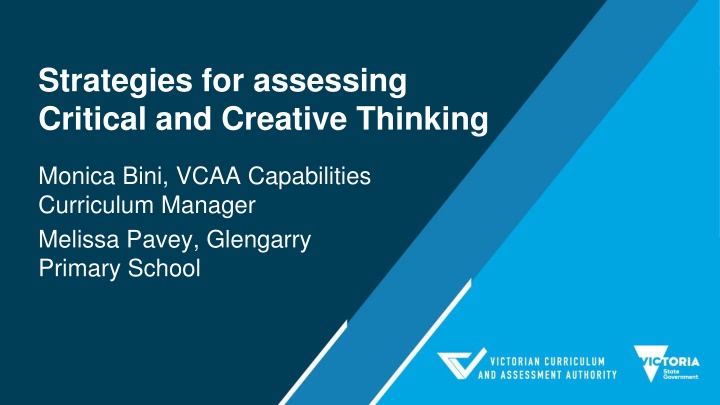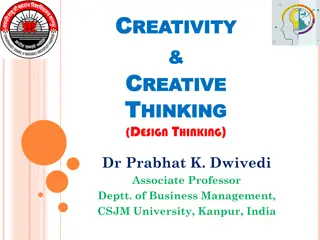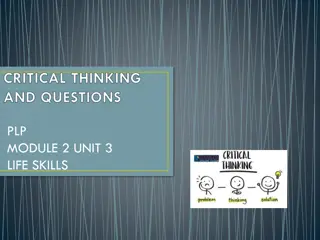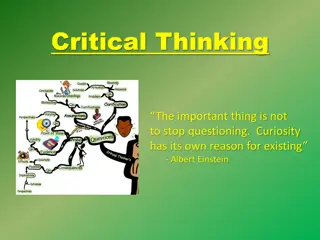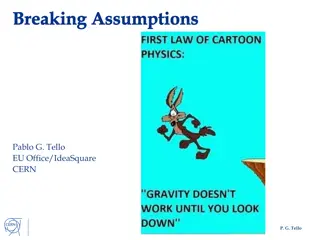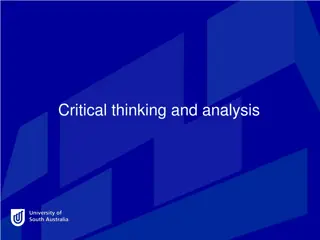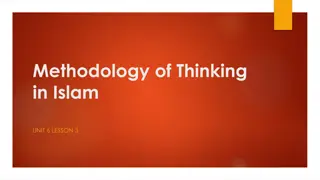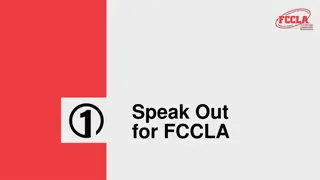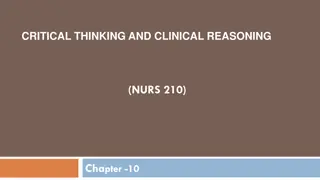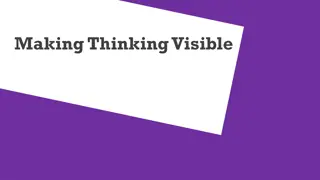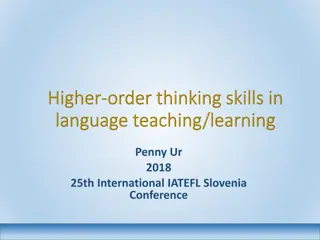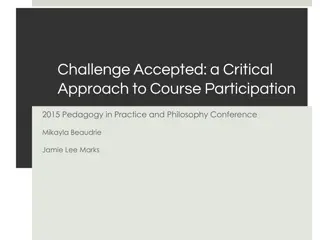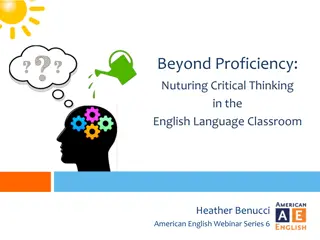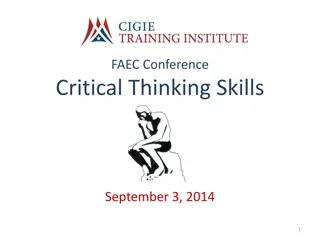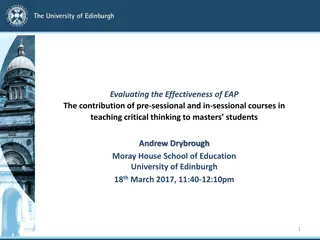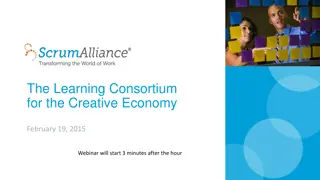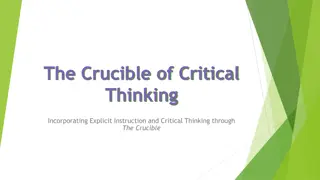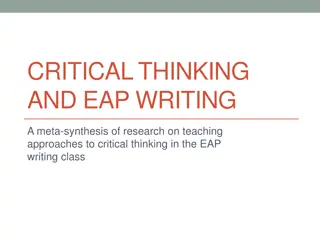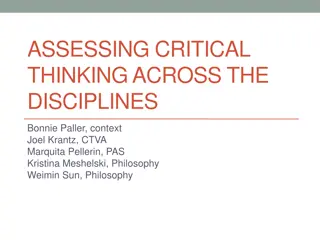Strategies for Assessing Critical and Creative Thinking
Gain insight into assessment methods suited to Critical and Creative Thinking, linking assessment and planning, and advice on planning and assessment strategies for each strand. Explore questions and possibilities related to reasoning, meta-cognition, and developing ideas, with example assessment methods like Lotus Diagram and Compass Points strategy in the context of arts, culture, and historical events.
Download Presentation

Please find below an Image/Link to download the presentation.
The content on the website is provided AS IS for your information and personal use only. It may not be sold, licensed, or shared on other websites without obtaining consent from the author.If you encounter any issues during the download, it is possible that the publisher has removed the file from their server.
You are allowed to download the files provided on this website for personal or commercial use, subject to the condition that they are used lawfully. All files are the property of their respective owners.
The content on the website is provided AS IS for your information and personal use only. It may not be sold, licensed, or shared on other websites without obtaining consent from the author.
E N D
Presentation Transcript
Strategies for assessing Critical and Creative Thinking Monica Bini, VCAA Capabilities Curriculum Manager Melissa Pavey, Glengarry Primary School
Objectives To gain insight into: - How assessment and planning can be linked - Assessment methods suited to Critical and Creative Thinking
Overview of session Part one: Assessment methods for each strand Part two: Advice on planning and assessment
Structure Critical and Creative Thinking Strands Questions and Possibilities understanding: Reasoning Meta-cognition how to: the use of strategies to: the nature of questioning compose, analyse and evaluate arguments and reasoning understand, manage and reflect on thinking and learning processes processes and techniques to develop ideas
Questions and Possibilities When faced with a challenge can I identify a helping strategy, know how to use it and reflect on its usefulness? Challenges might include: Analysing and constructing questions for a particular purpose Managing preconceptions when generating or evaluating possibilities Generating ideas when stuck
Example assessment methods Understanding and use of a taught questioning tool Example: Lotus Diagram Understanding and use of taught possibility strategies Example: Compass points strategy
Lotus Diagram A form of concept mapping but more structured Can be used in different ways, and helps students frame their thinking Can be used to prompt thinking around set topics
Arts and culture Colonisation Aboriginal history Aboriginal history Arts and culture Colonisation Federation Anzac Day Anzac Day Australia Federation Reconciliation Week Student Choice Historical Event Migration Reconciliation Week Migration
Lotus Diagram
Lotus Diagram
Lotus Diagram
Lotus Diagram
Some new Aboriginal art might not be all symbols. It is more colorful than I thought I thought it was all made with rock dust. Do we know all of Aboriginal history if no one wrote it down? Maybe stories are another way of keeping history Australian art is not just Aboriginal art. There is also old paintings and people making art now How do we know if the history we know is true? It would have been written by the educated white people The emu in the sky is a type of aboriginal astronomy, can you see it anywhere in Australia? Colonization is when English people came to Australia with convicts in 1788. Are there any histories written by aboriginal people? If not why not? Aboriginal culture is one of the oldest on the planet! Aboriginal art is always made up of symbols that tell a story Were convicts able to write. They probably couldn t and they might not be allowed to have paper Dreamtime stories, possum skin cloaks, dot paintings, (name de-identified) s nan, I wonder if it was a really bad punishment or if people liked it here and had a better life. Convicts didn t make much art. Rich white people made art to keep a record of Australia But how do we know if the stories are just made up? Aboriginal history Arts and culture Colonisation Is graffiti an Australian art? Artifacts can be history we learnt about the eel traps that are older than the pyramids so they are a record of history I think aboriginal people were curious at first and then probably really confused and angry I think colonization was a good thing but maybe not for everyone. Maybe if England didn t come another country would What is federation? Is it like the federal government? Aboriginal history Arts and culture Colonisation Soldiers and wreaths When was federation? We march at the parade to remember the soldiers who died Anzac Day Federation Anzac Day Australia Federation Why do we have ANZAC day and rememberance day? One of them has poppies Student Choice Historical Event Reconciliation Week Migration Maybe migrants would not write down their stories. Maybe they would be scared to or wouldn t think it was important. If they were Chinese we couldn t read it. Although someone could. We did some fun activities one year. We made a fire and some Aboriginal people taught us games and made damper. One game was called Gorry I might choose Koziosko and MacMillan exploring Gippsland because I have seen their statues Migrants might have been able to read and write fine so we should have their stories recorded My gran had a hard time and thought she would have a better life. Maybe that s why people migrate. What does reconciliation mean? People are talking about if the explorers here were really doing what they said they were. I think we might not know all the story because they would have written their own accounts. Not all people are leaving a bad situation but many are. There can be push and pull factors. Probably everyone has different reasons (ended up choosing the Freedom Rides) Could I interview my gran? She came from Scotland. Reconciliation Week Migration I might like to investigate something from Aboriginal culture Why do people migrate? I don t want to do them.
Compass Points: managing preconceptions Needs Excitements Stance/ Steps/ Suggestions Worries Source: R.Ritchhart et. al Making Thinking Visible Jossey-Bass 2011
Compass Points: managing preconceptions Activity: Needs Excitements How could this be a strategy for managing preconceptions? Stance/ Steps/ Suggestions Worries Source: R.Ritchhart et. al Making Thinking Visible Jossey-Bass 2011
Compass Points: managing preconceptions Links to curriculum: Needs Excitements F-2 how could your worries and excitements affect what you think of stances different to yours? 7-8 check your excitements and worries against your suggestions: are these unduly limiting you? Stance/ Steps/ Suggestions Worries Source: R.Ritchhart et. al Making Thinking Visible Jossey-Bass 2011
Compass Points: managing preconceptions Assessment: Needs Excitements Can the student draw on the tool to reflect on how they managed their preconceptions? Can they identify another proposition where this tool would be useful? Stance/ Steps/ Suggestions Worries Source: R.Ritchhart et. al Making Thinking Visible Jossey-Bass 2011
Reasoning 1. Do I have the knowledge and skills to develop, analyse and evaluate the reasoning aspect of arguments? 2. Do I know how to apply reasoning and learning area knowledge and skills to assess the strength of arguments?
Assessment methods Identifying and explaining reasoning errors; or applying reasoning errors to create dramatic or comedic texts Analysing given arguments to identify structure Selecting, analysing and evaluating arguments representing different/opposing perspectives (for example through dialogue with peers; or a text based case study or inquiry)
Lotus Diagram Can be used to assess understanding of argument structure
Identifying argument structure: example See https://www.vcaa.vic.edu.au/assessment/f- 10assessment/formative-assessment/formative-assessment-rubric- samples/Pages/default.aspx
Identifying reasoning errors task Task Instructions Match each reasoning error with the correct example. Read the opinion piece. Annotate your copy of the opinion piece by highlighting and labelling: The main argument being made in the opinion piece. The reason(s) presented to support the argument being made in the opinion piece. Any reasoning errors. Write a justification for each error that you have identified in Question 3(c).
Metacognition Do I have a breadth and depth of understanding of metacognitive strategies? Can I select strategies to manage and reflect on mine and others thinking?
Example assessment methods Reflecting on how a metacognitive strategy or tool was used/should be used how it assists thinking Identifying their own examples of where metacognitive strategies might be useful Note: Assess through practical contexts where level of challenge high enough to require metacognition
Written reflection Students taught to write reflections in their maths books Reflect on difficulty of the task, what they learnt or practised and how they know; and effectiveness of methods Stems used as prompts I learnt I was practicing I prefer because
SOLO taxonomy can be used to write tiered success criteria. Teaching kids to use it for their own self-assessment
Planning and assessment Creating a culture of thinking and developing a shared language are key for students Explicitly planning and explicitly teaching is key for teachers
Planning and assessment The link between teaching and assessment Formative assessment relies on shared language Concepts underlying this shared language must be explicitly taught Level of challenge such that guaranteed and viable for every student
Planning Planning Shared language Challenge Learning area concepts What are next steps in learning? CCT concepts
Contact Monica Bini: (03) 90321693 monica.bini@education.vic.gov.au
